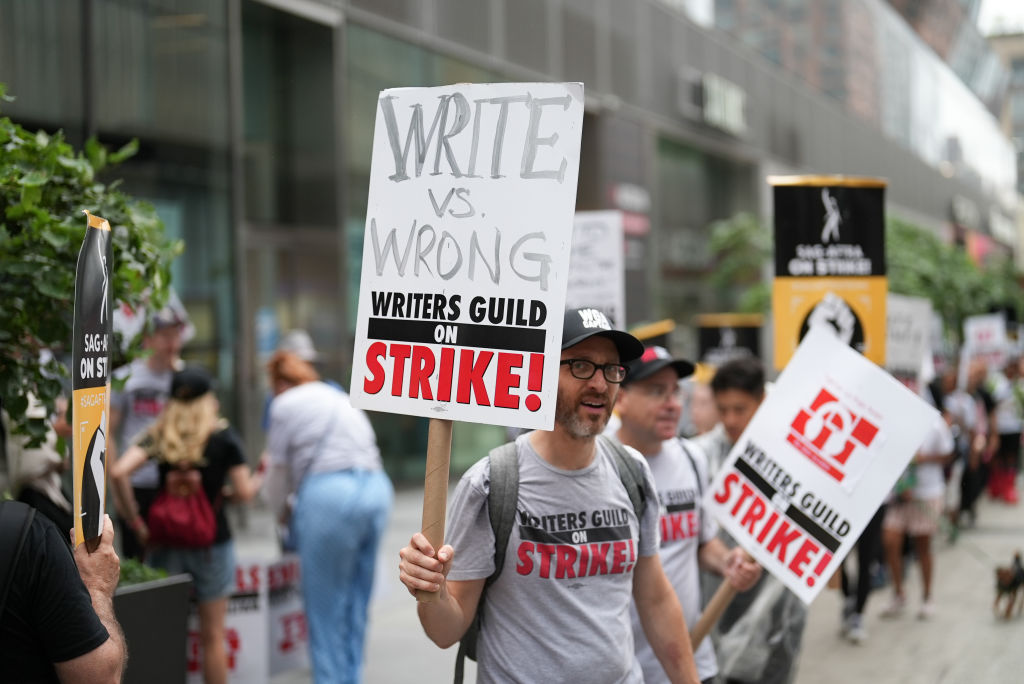Happy Tuesday! If you appreciate what we’re doing here at The Dispatch, we have a small favor to ask: Forward this email to someone (or a few someones) in your life who might enjoy getting TMD every morning. Let them know why you’re a reader, and that they can click “sign up for this newsletter” at the top of the email to get Wednesday’s edition in their inbox. For the next few days, the members-only version of The Morning Dispatch will be unlocked for all to read.
To do more of the kind of work we want to do, we need more members. And the best way to get more members is word of mouth from the people who know us best. Thanks for your help.
Quick Hits: Today’s Top Stories
- At least 2,000 people are feared dead in Libya and thousands more are missing after a storm along the country’s coast produced severe flooding, government officials say. A spokesperson for the Libyan National Army reported that dams above the coastal town of Derna collapsed, “sweeping whole neighborhoods with their residents into the sea.” Reliable numbers on the death toll have yet to emerge as the country reels from the damage—Derna was still inaccessible as of Monday evening. “Early reports indicate that dozens of villages and towns have been severely affected by the storm, with widespread flooding, damage to infrastructure, and loss of life,” said Georgette Gagnon—the United Nations resident coordinator in Libya.
- The Food and Drug Administration on Monday greenlit updated COVID-19 vaccines from Moderna and Pfizer that target XBB.1.5, an Omicron subvariant that was the dominant strain in the United States earlier this summer. XBB.1.5 appears to have been overtaken by newer strains (EG.5 and BA.2.86) in recent weeks, but Moderna and Pfizer said the updated vaccines still produced a strong immune response when tested against the new variants. Once Dr. Mandy Cohen, director of the Centers for Disease Control (CDC), signs off on the boosters later this week, anyone over the age of four will be eligible to receive the updated shot two months after their most recent dose of a COVID-19 vaccine. The updated vaccine schedule for children under the age of five depends on their previous vaccination status. New COVID-19 cases have been surging in recent weeks, but public health experts who spoke with TMD last week are not overly concerned about a rise in severe illness or death associated with the virus.
- The Biden administration has reportedly issued a sanctions waiver in recent days authorizing South Korea to move $6 billion in frozen Iranian oil revenues to a bank in Qatar, moving forward with a deal made public last month that would secure the freedom of five wrongfully detained Americans being held in Iranian prisons. The U.S. will also release five detained Iranians as part of the deal. The Biden administration claims the transferred funds will only be used for humanitarian purposes, though several Iran experts dispute that characterization and Iranian officials have said there are no limits on their use of the funds.
- North Korean leader Kim Jong Un reportedly arrived in Russia early this morning for a summit with President Vladimir Putin expected to take place this week. The trek is the first international trip Kim has taken since the beginning of the pandemic, and only his second meeting with Putin after their first summit in 2019. No specific agenda for the meeting has been released—North Korean state news said the two leaders would “meet and have a talk”—but U.S. officials expect the countries to discuss potential arms deals to aid Russia in the war in Ukraine.
Hot Labor Summer?

With a number of high-profile strikes and almost-strikes taking place this summer, it looks like the labor movement in the United States is having a moment. Americans have spent the past decade telling pollsters about their increasing support for unions, and then they elected a president who claims he’s the most pro-union occupant of the White House in history. But the strikes and that professed enthusiasm belie the reality: The rate of union membership in the United States has steadily decreased over the last four decades, dropping by roughly half between 1983 and 2022 to 10.1 percent of workers. With United Auto Workers threatening to strike at the end of the week, how much power does today’s worker wield?
The U.S. workforce has seen dramatic changes in recent decades—from the widespread disruptions caused by advances in information technology to the upheaval of the global pandemic, very few workers today occupy jobs performed as they had been just a few years ago. With more change coming after the arrival of artificial intelligence and a tight labor market that gives workers leverage, the prospect of more aggressive labor action is real. “We are certainly seeing more contentious labor relations and more of a push on the labor union side in the negotiations this summer,” Alexander Colvin, dean of Cornell’s School of Industrial and Labor Relations, tells TMD. “Workers and their unions are looking to make up ground from the inflation of the last couple of years, and they have more bargaining power because of low unemployment and a strong economy,” Colvin adds. Plus, he notes, many high-profile unions have a slate of new, more aggressive leaders willing to take the fight to management in innovative ways.
But even as labor activity makes headlines this summer, union membership has been declining for decades, with just one in ten workers belonging to a union, according to the Bureau of Labor Statistics. Far more Americans are interested in the idea of organized labor. A Gallup poll released last month found that 67 percent of Americans said they were in favor of unions, down from its nearly 60-year high of 71 percent last year. That figure recovered from 2009, when unions faced the lowest support ever recorded, with just 48 percent of Americans approving of them.
The chasm between what people say about unions and their seeming unwillingness to join one reads like a contradiction, though it might not be. “Unions traditionally serve as the counterbalance to employer and management power,” Colvin says. And the weaker they get, the more people may feel the need to support them as a counterweight, even if that support doesn’t extend to membership.
Labor’s high-profile opening salvo this summer came with the Writers Guild of America (WGA) stoppage, which started in early May after negotiations with production companies over pay and streaming residuals—how much money a writer gets when their show is viewed on streaming services like Netflix—broke down. “The companies’ behavior has created a gig economy inside a union workforce,” the WGA said when they announced the strike.
Then, as we reported in July, the actors joined the writers on strike 10 weeks later, amid growing concern about the shifting dynamics of the entertainment industry’s profit model and concerns about the way artificial intelligence could change the industry. As we wrote then:
Another major point of contention in the negotiations has to do with the use of artificial intelligence to scan background actors and train generative AI systems—an innovation that could essentially eliminate the jobs of an unseen but substantial contingent of Hollywood performers. SAG-AFTRA is asking for a commitment that studios won’t use actors’ performances to train AI systems without obtaining their consent and compensating them.
Those twin strikes are still going, with potentially serious economic consequences: One estimate from early August placed the cost of the dual stoppages for California’s economy at $3 billion, perhaps more.
There have been some near-misses in the last few months, too—some of which, had they gone forward, would have made the cost of the Hollywood strikes look like pocket change. In June, for example, acting Labor Secretary Julie Su stepped in to resolve a dispute between the International Longshore and Warehouse Union and the Pacific Maritime Association—a group of employers at U.S. West Coast ports, including the bustling port of Los Angeles/Long Beach. After 13 months of contentious negotiations, the deal struck June 14 helped avoid potential losses of $1 billion a day and serious supply chain disruptions.
United Parcel Service (UPS) members of the International Brotherhood of Teamsters agreed to a deal in early August, averting a strike of 300,000 UPS employees that would have created more delivery delays than UPS’ competitors could have shouldered. The new five-year contract included immediate and future pay hikes for current full and part-time employees, as well as the promise of air conditioning in delivery vans. “Our members just ratified the most lucrative agreement the Teamsters have ever negotiated at UPS,” said Sean M. O’Brien, the Teamsters president. “This contract will improve the lives of hundreds of thousands of workers.”
United Auto Workers (UAW) may well be speeding toward a strike this week at the three unionized U.S. automakers—Stellantis (Chrysler’s parent company), General Motors, and Ford—that could start when the clock strikes midnight on Thursday night and the 146,000 workers’ current contracts expire. Negotiations between management at the three companies and UAW are ongoing, but time is ticking down. “We are on a good path and remain committed to reaching a tentative agreement without a work stoppage that would negatively impact our employees and our customers,” officials at Stellantis told their employees in an email Monday.
A deal may ultimately be struck as both sides make last-minute concessions, but the union was seeking an immediate 20 percent raise for its workers and four additional pay hikes of 5 percent apiece down the road; changes to pensions plans that make them sensitive to inflation; and a “just transition” to electric vehicle production for workers whose jobs may be at risk as the “Big Three” automakers move away from production of traditional gas cars. Attempts to respond to rapid technological change are at the heart of many of the current strikes and heated contract renegotiations, Colvin argues. “A technology-driven set of issues has been a factor that often produces more difficult negotiations because things aren’t settled,” he says, pointing to the AI concerns in the Hollywood strike and the shift to EVs in the car industry. “The auto workers [are concerned] about the shift to electric cars, electric batteries, and whether their members are going to have an opportunity to be making those vehicles and batteries.”
UAW could move to strike at one, two, or all of the Big Three companies. Analysis from Anderson Economic Group suggests that even a 10-day strike by workers at all three companies would cost the wider economy $5 billion.
The Biden administration often claims to be the most pro-labor administration in history—and it’s hard to deny their rhetorical support for the movement. The White House has issued statements in support of striking writers and actors’ right to “fair pay and benefits,” and said last month “the UAW deserves a contract that sustains the middle class.” That support is mutual: The AFL-CIO, the largest federation of unions in the U.S., has already endorsed Biden in his 2024 reelection bid.
But it’s difficult to balance rhetorical support for unions with the fact that Biden’s green energy push is prompting at least some of the upheaval in the automobile industry—a fact the White House carefully alluded to in its statement acknowledging the possibility of a UAW strike. Auto companies, the Biden administration said, “should take every possible step to avoid painful plant closings” and “ensure that when transitions are needed, the transitions are fair and look to retool, reboot, and rehire in the same factories and communities at comparable wages, while giving existing workers the first shot to fill those jobs.”
Su—whose nomination was stalled when she lost the support of moderate Democratic Sen. Joe Manchin of West Virginia and independent Sen. Kyrsten Sinema of Arizona for being too progressive—has said that it’s the Biden administration’s policy to “stay out” of labor disputes as much as possible. That approach often favors labor, Colvin says. But the administration has occasionally stepped in when a potential strike would have serious implications for supply chains or the broader economy. Such was the case with the Longshore dock workers negotiations, and, most notably, when it moved to block railway workers from striking in December of last year. Biden signed a bill enshrining the agreement between railway workers and operators into law ahead of the strikes and after months of chaotic negotiations.
Labor disputes have gotten significant media attention this year and if 150,000 auto workers go on strike later this week, the number of striking workers will reach “heights rarely seen in recent decades,” according to a New York Times analysis. But according to Cornell’s “Labor Action Tracker,” the number of strikes (250) is actually down in 2023, compared to the same point in 2022 (290).
The Dispatch Takes Des Moines!
After a great turnout at our event in Milwaukee last month, Steve and Declan are headed to Des Moines, Iowa, on September 21 for an informal meet-and-greet with members of The Dispatch community. Join us for a drink, a chat, and a one-hour Q&A on the news of the day and all things Dispatch. We’ll be covering beer and wine for the first hour and a half—and feel free to bring non-members so we can grow our community.
More details can be found here and below. We hope to see you there!
Where: Twisted Vine Brewery, 112 SE 4th St., Des Moines, IA 50309
When: Thursday, September 21, at 6 p.m. CT
Registration: https://forms.gle/WJSsHNQc7SWLK5zG9
Worth Your Time
- The U.S. might be home to a record-setting deposit of lithium along the Nevada-Oregon border, a game-changer as the world races to discover more of the crucial substance. “An estimated 20 to 40 million tonnes of lithium metal lie within a volcanic crater formed around 16 million years ago,” Anthony King reports for Chemistry World. “This is notably larger than the lithium deposits found beneath a Bolivian salt flat, previously considered the largest deposit in the world. New in situ analysis reveals that an unusual claystone, composed of the mineral illite, contains 1.3 percent to 2.4 percent of lithium in the volcanic crater. This is almost double the lithium present in the main lithium-bearing clay mineral, magnesium smectite, which is more common than illite. Thomas Benson, a geologist at Lithium Americas Corporation, says his company expects to begin mining in 2026. It will remove clay with water and then separate out the small lithium-bearing grains from larger minerals by centrifuging. The clay will then be leached in vats of sulfuric acid to extract lithium. ‘If they can extract the lithium in a very low energy intensive way, or in a process that does not consume much acid, then this can be economically very significant,’ says Anouk Borst, a geologist at KU Leuven University and the Royal Museum for Central Africa in Tervuren, Belgium. ‘The US would have its own supply of lithium and industries would be less scared about supply shortages.’”
Presented Without Comment
CNN: Biden Falsely Claims He Was at Ground Zero ‘The Next Day’ After 9/11
Also Presented Without Comment
Associated Press: DraftKings Apologizes for Sports Betting Offer Referencing 9/11 Terror Attacks
Also Presented Without Comment
The Hill: [Former New Jersey Gov. Chris] Christie Says He’ll Follow Trump ‘Around the Country’ if Former President Doesn’t Debate
Toeing the Company Line
- It’s Tuesday, which means Dispatch Live (🔒) returns tonight at 8 p.m. ET/5 p.m. PT! Kevin will be joined by Steve, Warren, Grayson, and Mary to discuss the news of the week and, of course, take plenty of viewer questions! Keep an eye out for an email later today with information on how to tune in.
- In the newsletters: The Dispatch Politics crew outlines Nikki Haley’s strategy to break away from the rest of the pack and Nick argues (🔒) that New Mexico’s Gov. Michelle Lujan Grisham is using her “emergency powers” like a dictator.
- On the podcasts: On the latest Advisory Opinions, David French and guest host David Lat discuss Mark Meadows’ recent court loss and the 5th Circuit’s injunction against the Biden administration over its communications with social media companies.
- On the site today: Charlotte reports from Tel Aviv on Israel’s response to growing terrorist threats from Iran and Chris explains what the Virginia midterm elections will mean for Gov. Glenn Youngkin and 2024.
Let Us Know
Have you ever belonged to a union? Do you think the decline in union membership in the United States has been, on net, a negative or positive development?







Please note that we at The Dispatch hold ourselves, our work, and our commenters to a higher standard than other places on the internet. We welcome comments that foster genuine debate or discussion—including comments critical of us or our work—but responses that include ad hominem attacks on fellow Dispatch members or are intended to stoke fear and anger may be moderated.
With your membership, you only have the ability to comment on The Morning Dispatch articles. Consider upgrading to join the conversation everywhere.